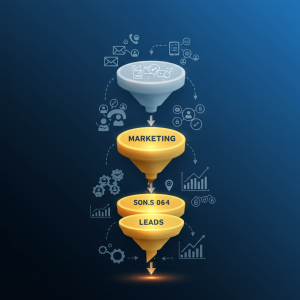Predictive Engagement Strategies When Traditional Buying Signals Go Dark

Sales teams worldwide face an unprecedented challenge. The reliable buying signals that once guided engagement decisions have started vanishing from customer interactions. Email opens plateau at historic lows while website visits become sporadic and unpredictable.
Modern buyers have learned to research solutions without leaving digital breadcrumbs. They browse privately, use company devices that mask individual behavior, and collaborate through internal channels that remain invisible to vendor tracking systems.
This transformation demands entirely new approaches to customer engagement. Traditional metrics like page views and email clicks no longer provide meaningful insight into purchase readiness or timing.
The most successful sales organizations now operate like intelligence agencies, gathering insights from multiple sources while building engagement strategies that function effectively even in information-scarce environments.
The New Buyer Behavior Reality
Today’s purchasing decisions happen in corporate conference rooms and private messaging apps rather than on vendor websites. Buyers deliberately avoid leaving traces that might trigger unwanted sales outreach during their research phases.
Committee-based buying processes further complicate signal detection. Multiple stakeholders research independently, share findings privately, and coordinate decisions through internal meetings that vendors never see.
Economic uncertainty has extended evaluation timelines significantly. Buyers spend months researching options without engaging vendors directly, preferring to gather complete information before initiating contact.
Privacy regulations and browser security updates have eliminated many traditional tracking methods. Third-party cookies disappear while email clients increasingly block read receipts and link tracking.
The rise of peer networks and industry forums means buyers access detailed product information through channels that bypass vendor marketing entirely. Professional communities provide unfiltered insights that buyers trust more than official marketing materials.
Building Intelligence Through Relationship Networks
Success in this new environment requires developing human intelligence networks that function independently of digital tracking systems. These relationships provide insights that technology cannot capture.
Industry connections offer early warning systems for market changes and customer needs. Trade association members, conference speakers, and industry analysts often possess information about customer plans before formal requirements emerge.
Partner ecosystems provide visibility into customer activities across multiple vendor relationships. System integrators, consultants, and channel partners frequently understand customer priorities better than direct vendors.
Customer advisory boards and user communities create natural intelligence gathering opportunities. Active participants often reveal organizational challenges and priorities during informal discussions.
Professional development activities indicate individual priorities that typically align with organizational needs. Certification programs, training attendance, and conference participation suggest technology adoption plans.
Former employees who maintain relationships with previous organizations can provide valuable context about internal processes and decision-making patterns. These connections offer insights into cultural factors that influence purchasing behavior.
Micro-Signal Recognition Techniques
Effective predictive engagement depends on identifying subtle behavioral changes that precede traditional buying indicators. These micro-signals often appear weeks or months before conventional metrics show increased activity.
Organizational announcements frequently reveal changing priorities before formal solution requirements emerge. Leadership changes, strategic initiatives, and restructuring activities create needs that proactive vendors can anticipate.
Communication pattern shifts indicate evolving internal processes. Changes in response times, meeting participants, and preferred communication channels suggest shifting decision-making dynamics.
Budget cycle awareness enables timing predictions for purchasing activity. Understanding fiscal calendars and planning processes helps identify when dormant prospects may suddenly become active.
Technology environment changes create solution needs that customers may not immediately recognize. Platform migrations, security incidents, and compliance requirements generate opportunities for prepared vendors.
Competitive landscape monitoring reveals market movements that affect customer behavior. Understanding when competitors win or lose major deals provides context for your own prospect engagement strategies.
Contextual Engagement Frameworks
Predictive engagement succeeds by understanding broader business contexts that influence customer decision-making. These frameworks anticipate needs based on industry trends and organizational circumstances rather than individual behavioral signals.
Market condition analysis helps identify when external factors create solution requirements within customer organizations. Economic pressures, regulatory changes, and competitive dynamics generate predictable need patterns.
Industry lifecycle understanding reveals common challenges that organizations face at different growth stages. Startup scaling requirements, enterprise optimization needs, and transformation initiatives create distinct engagement opportunities.
Seasonal business patterns influence purchasing priorities across different sectors. Understanding these cycles helps maintain appropriate communication frequency and messaging relevance throughout extended sales processes.
Crisis preparedness enables responsive engagement when unexpected events accelerate customer decision-making. Natural disasters, security breaches, and regulatory changes often compress evaluation timelines dramatically.
Merger and acquisition activity creates immediate solution needs as organizations integrate systems and processes. Monitoring corporate development announcements provides early indicators of upcoming projects.
Technology-Enhanced Pattern Detection
Advanced analytics platforms excel at identifying engagement patterns across multiple touchpoints and extended timeframes. These systems find correlations that human observers might miss in complex customer journeys.
Cross-channel behavior analysis reveals customer intent through combined activity patterns rather than individual signal strength. Prospects may reduce activity in one channel while increasing engagement through others.
Network effect modeling identifies how customer organizations influence each other’s purchasing decisions. Understanding these influence patterns helps predict when dormant prospects may become active due to peer organization activities.
Timing pattern recognition discovers cyclical behaviors that suggest optimal engagement windows. Historical analysis reveals when prospects typically research solutions, enabling proactive outreach during likely active periods.
Content consumption velocity tracking identifies when research acceleration or deceleration occurs. These changes often indicate internal process shifts that affect purchasing urgency and decision-making authority.
Competitive intelligence integration provides context for customer behavior changes. Understanding competitor activities helps explain prospect engagement patterns and timing variations.
Value-First Communication Strategies
Maintaining customer attention during signal-dark periods requires shifting from direct sales messaging to educational value delivery. These approaches preserve relationship momentum while respecting customer preferences for reduced vendor interaction.
Industry insight sharing positions your organization as a trusted advisor rather than another vendor seeking attention. Research findings, trend analysis, and best practice documentation maintain relevance during customer research phases.
Collaborative planning discussions help customers envision solution benefits and implementation approaches. These forward-looking conversations maintain engagement while providing valuable insights into customer priorities.
Educational content syndication through neutral third-party channels enables continued customer development without requiring direct interaction. Industry publications and professional networks provide valuable distribution alternatives.
For comprehensive approaches to modern customer engagement challenges, platforms like Outbound Marketo offer proven frameworks for navigating complex sales environments and maintaining relationship momentum.
Thought leadership development establishes credibility that supports engagement during extended evaluation periods. Speaking engagements, research publications, and advisory positions maintain visibility without creating sales pressure.
Proactive Account Development Models
Long-term customer relationship investment strategies treat major prospects as multi-year development opportunities rather than quarterly sales targets. This perspective enables sustained engagement through multiple buying cycles and organizational changes.
Strategic account mapping identifies all stakeholders and influence networks within target organizations. Understanding these relationships enables more effective engagement regardless of individual signal strength.
Collaborative value creation projects provide natural engagement opportunities that feel consultative rather than sales-focused. Joint research initiatives, pilot programs, and strategic planning sessions build relationships while demonstrating capabilities.
Customer success story development showcases relevant implementations without direct selling. Case studies and reference conversations provide valuable content while maintaining prospect engagement.
Industry community building creates neutral venues for ongoing customer interaction. User groups, advisory panels, and professional development programs foster relationships without explicit purchasing pressure.
Measuring Relationship Development Progress
Predictive engagement measurement requires metrics that capture relationship quality and development trajectory rather than traditional activity-based indicators. These measurements provide insight into long-term customer potential.
Relationship depth assessment evaluates customer willingness to engage in strategic discussions and collaborative activities. These qualitative indicators often predict purchasing likelihood more accurately than behavioral metrics.
Influence network expansion tracks your organization’s connection development within target accounts. Broader relationship networks typically correlate with higher win rates and shorter sales cycles.
Customer advocacy indicators measure satisfaction and reference willingness among existing clients. Strong advocacy typically precedes referral generation and competitive displacement opportunities.
Competitive positioning strength evaluates your standing relative to incumbent vendors and alternative solutions. This assessment helps prioritize engagement investment and strategy development.
Long-term pipeline contribution analysis reveals whether predictive engagement strategies successfully identify and develop high-value opportunities. This perspective justifies investment in extended development cycles.
Sustained Engagement Through Extended Cycles
Maintaining meaningful customer relationships during signal-sparse periods requires disciplined communication strategies that provide value without creating sales pressure. These approaches preserve positioning while respecting customer autonomy.
Content calendar development ensures consistent value delivery without overwhelming prospects with excessive communication. Strategic timing and relevant messaging maintain attention without triggering avoidance behaviors.
Community participation creates natural interaction opportunities that feel collaborative rather than sales-focused. Industry forums, professional associations, and user groups provide neutral engagement venues.
Patience combined with persistent value delivery builds trust and credibility that eventually translates into purchasing consideration. This long-term perspective enables relationship investment that competitors often cannot match.
Predictive engagement requires accepting that modern customer relationships develop over extended timeframes with limited visibility into internal decision-making processes. Organizations that master relationship intelligence and contextual awareness maintain competitive advantages even when traditional tracking methods provide minimal insight into customer purchasing intent.





